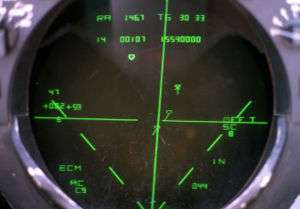AN/AWG-9

The AN/AWG-9 and AN/APG-71 radars are all-weather, multi-mode X band pulse-Doppler radar systems used in the F-14 Tomcat. It is a very long-range air-to-air system with the capability of guiding several AIM-54 Phoenix or AIM-120 AMRAAM missiles at the same time using its track while scan mode. The primary difference between the AWG-9 and APG-71 is the replacement of the former's analog electronics with all-digital units. Both the AWG-9 and APG-71 were designed and manufactured by Hughes Aircraft; contractor support is now being provided by Raytheon. The AWG-9 was originally developed for the failed Naval F-111B program.[1]
The AN/AWG-9 offers a variety of air-to-air modes including long-range continuous wave velocity search, range-while-search at shorter ranges, and the first use of an airborne track-while-scan mode with the ability to track up to 24 airborne targets, display 18 of them on the cockpit displays, and launch against 6 of them at the same time. This function was originally designed to allow the Tomcat to shoot down formations of bombers at long range.
AN/AWG-9
The AWG-9 was the result of a series of Navy programs to build what was known as a "fleet-defense fighter"; an aircraft armed with extremely long-range radars and missiles that would be able to engage formations of enemy aircraft well-away from aircraft carriers. Their first attempt was the F6D Missileer, which combined Westinghouse's AN/APQ-81 pulse doppler radar with the Bendix AAM-N-10 Eagle missile. The Missileer was a relatively simple aircraft, and when planners expressed doubts about its ability to survive after firing its missiles, the Missileer was canceled and the Navy started looking for higher-performance alternatives.
At the same time, the U.S Air Force had been working on a similar long-range interceptor project of their own, the XF-108 Rapier. The Rapier had much better performance than the Missileer, although its AIM-47 Falcon and AN/ASG-18 radar, both from Hughes, were somewhat less advanced than their Navy counterparts. The entire system was also very expensive, and the Rapier was canceled, replaced by the hopefully less-expensive Lockheed YF-12 adapted from the Lockheed A-12 spy plane. This project was also canceled as the strategic threat moved from bombers to ICBM's.
The same was not true for the Navy, where the threat remained manned aircraft and early anti-ship missiles. Hughes suggested that the AN/ASG-18 and AIM-47 could be adapted for the Navy in slightly modified form, adding additional tracking capability while reducing the size of the radar antenna to a size more suitable for carrier aircraft. The result was the AN/AWG-9 radar and Phoenix missile.
All that was needed was a suitable airframe, which led to the Navy's involvement in the F-111B program. Although the radar and missile systems started to mature (after the better part of a decade at this point) the F-111B proved to be considerably overweight and had marginal performance, especially in engine-out situations. At the same time, real-world combat over Vietnam was proving that the idea of the all-missile fighter was simply not viable, and any fighter design would have to be able to dogfight with guns, which the F-111 was simply not suited to. This should not be surprising given the F-111's genesis as a tactical bomber and interdictor.
After many years in development and arguing with Congress, the Navy finally started development of a new aircraft specifically tailored to their needs. The new aircraft emerged as the F-14, armed with the same AWG-9/AIM-54 outfit originally intended for the F-111B. On the F-14, the AWG-9 is capable of detecting bomber-sized targets at ranges exceeding 100 miles (160 km), and its doppler system allows it to have look-down, shoot-down capabilities.[2] Track-while-scan capability is provided by an Intel 8080 8-bit microprocessor; programming it is accomplished using an 8-bit Assembly code.
Hughes delivered enough AWG-9 systems and spares to equip approximately 600 F-14A/B aircraft for the Navy, and an additional 78 aircraft for the Iranian Air Force. All of the Navy systems have been retired; the status of the Iranian systems is unknown, but it is believed that they are still in service.
AN/APG-71
The APG-71 was a 1980s upgrade of the AWG-9 for use on the F-14D. It incorporates technology and common modules developed for the APG-70 radar used in the F-15E Strike Eagle, providing significant improvements in (digital) processing speed, mode flexibility, clutter rejection, and detection range. The system features a low-sidelobe antenna, a sidelobe-blanking guard channel, and monopulse angle tracking; all of which are intended to make the radar less vulnerable to jamming.
The system itself is capable of a 460-mile (740 km) range, but the antenna design limits this to only 230 miles (370 km). Use of datalinked data allows two or more F-14Ds to operate the system at its maximum range.
Hughes delivered enough APG-71 radars and spares to equip 55 F-14Ds before the program was scaled back as a cost-cutting measure and eventually canceled. The F-14 was officially retired from United States Navy service on September 22, 2006, with the last flight occurring October 4, 2006. The last navy squadron utilizing the F-14 was VF-31.
References
Notes
Citations
Bibliography
- Sweetman, Bill and Bonds, Ray. The Great Book of Modern Warplanes. New York, New York: Crown Publishers, 1987. ISBN 0-517-63367-1